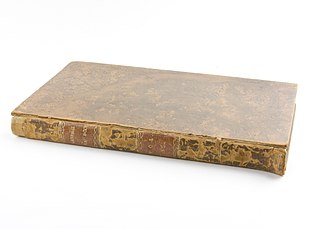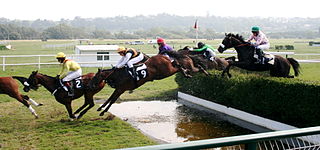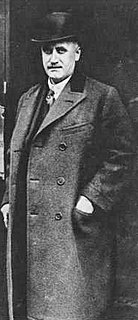
Tetratema was an Irish-bred, British-trained Thoroughbred racehorse and sire. In a racing career which lasted from May 1919 until October 1921 he won thirteen of his sixteen races, include the all twelve of his starts over the sprint distances of five and six furlongs. He was unbeaten in five races in 1919, including the Molecomb Stakes, Champagne Stakes, and Middle Park Stakes, and was the highest-rated two-year-old in Britain by a record margin. In the following year he had enough stamina to win the Classic 2000 Guineas over a mile, but failed to stay when unplaced in both The Derby and the Eclipse Stakes. He then returned to sprinting and won his remaining two races of 1920 and all four in 1921. His successes in this phase of his career included the King's Stand Stakes, July Cup and two runnings of the King George Stakes.

Conduit is a retired Thoroughbred racehorse and active sire. In a career that lasted from August 2007 to November 2009 he won seven of his fifteen starts, including four at Group One/Grade I level.
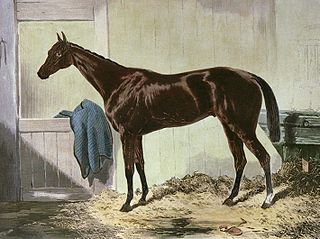
Blue Gown was a British Thoroughbred racehorse that was the winner of the 1868 Epsom Derby and Ascot Gold Cup. He was one of the best colts of his generation at two, three years and four of age, but his form declined in 1870 after an unsuccessful period in France. He was retired to stud, where he had considerable success as a sire of winners in Germany. Blue Gown died in 1880 while being shipped to the United States.

Spion Kop (1917–1941) was an Irish-bred, British-trained Thoroughbred racehorse and sire. In a career that lasted from 1919 until 1921, Spion Kop ran fourteen times winning two races. After an undistinguished early career in which he lost his first six races, he improved as a three-year-old to win The Derby in record time in 1920. After his retirement from racing he had some success as a stallion.

Isonomy was a British Thoroughbred racehorse and sire. In a career that lasted from 1877 to 1880 he ran fourteen times and won ten races. As a three-year-old he deliberately bypassed the Classics in order that his owner could land a massive betting coup in the Cambridgeshire Handicap at Newmarket. In the following two seasons he was the dominant stayer in Britain, producing a series of performances which led many contemporary observers to regard him as one of the greatest racehorses of the 19th century. He was then retired to stud, where he became a successful stallion.

Favonius (1868–1877) was a British Thoroughbred racehorse and sire. In a career that lasted from 1871 to 1873 he ran ten times and won five races. In June 1871 he won The Derby on his second racecourse appearance. He went on to prove himself a top class stayer, winning the Goodwood Cup in 1872. Favonius was regarded by contemporary observers as one of the best English-trained horses of his era. At the end of the 1873 season he was retired to stud but had little chance to make an impact as a stallion before his death four years later. Favonius’s Derby win was one of the highlights of what became known as “The Baron’s Year”, in which his owner, Baron Meyer de Rothschild won four of the five British Classic Races.

Paradox (1882–1890) was a British Thoroughbred racehorse and sire. In a career that lasted from October 1884 until October 1885 he ran eight times and won six races. Despite running only twice in 1884, he proved himself to be one of the best two-year-olds of his generation by winning the Dewhurst Plate. In the following year he won five of his six races including the 2,000 Guineas, the Grand Prix de Paris, the Sussex Stakes and the Champion Stakes. His only defeat came when he was narrowly beaten by Melton in The Derby.
Aggressor was a British Thoroughbred race horse and sire. In a racing career which lasted from 1957 until July 1960 he ran twenty times and won eleven races. In his first three seasons he showed solid form, winning races including the Solario Stakes, the Coronation Stakes and the Cumberland Lodge Stakes. He reached his peak as a five-year-old in 1960 when he won the John Porter Stakes and the Hardwicke Stakes before recording his biggest success when defeating the outstanding filly Petite Etoile in the King George VI and Queen Elizabeth Stakes.
Tracery (1909–1924) was an American-bred, British-trained Thoroughbred racehorse and sire, best known for winning the St. Leger Stakes in 1912. In a career which lasted from June 1912 until October 1913 he ran nine times and won six races. After finishing third on his debut in the 1912 Epsom Derby Tracery never lost another completed race at level weights. He won the St. James's Palace Stakes, Sussex Stakes and St. Leger Stakes in 1912 and the Eclipse Stakes and Champion Stakes as a four-year-old in 1913. He was brought down by a protester in the 1913 Ascot Gold Cup. After his retirement from racing he became a highly successful breeding stallion in Britain and Argentina.
Black Tarquin (1945–1965) was an American-bred, British-trained racehorse and sire, best known for winning the St. Leger Stakes in 1948 and for his rivalry with Alycidon. In a career which lasted from June 1947 until July 1949, he ran fifteen times and won eight races. He was one of the leading two-year-olds of 1947, although he did not race after winning the Gimcrack Stakes in August. He was slow to reach peak fitness in 1948, and was unplaced in The Derby, but showed his best form in autumn when he beat a strong field in the St. Leger Stakes. His form continued into the following spring, but his career was effectively ended by his defeat in the Ascot Gold Cup. The victories of Black Tarquin led to a change in the way in which the Thoroughbred was defined in Britain.

Black Jester (1911–1928) was a British Thoroughbred racehorse and sire, best known for winning the Classic St Leger Stakes in 1914. The colt won nine times from twenty-three races in a track career which lasted from 1913 until October 1915. Black Jester was one of the leading two-year-olds of 1913 when he won both Molecomb Stakes and the Richmond Stakes at Goodwood. As a three-year-old he finished third in the 2000 Guineas and was unplaced in The Derby before winning the Sussex Stakes at Goodwood and the St Leger at Doncaster in September. In 1915 he won the City and Suburban Handicap and the June Stakes, a wartime substitute for the Coronation Cup. He became increasingly difficult to train and at the end of the season he was retired to stud where he became a successful sire of broodmares.

Tiffin was a British Thoroughbred racehorse and broodmare, who was undefeated in a career of eight races. Tiffin won five races in 1928 including the National Breeders' Produce Stakes at Sandown Park and the Cheveley Park Stakes at Newmarket and was the highest-rated British two-year-old of either sex. Her three-year-old season was disrupted by illness and injury, but she won all three of her starts, proving herself the year's best sprinter with wins in the July Cup at Newmarket and the King George Stakes at Goodwood. At her peak she was regarded as one of the fastest racehorses in the world. At the end of her racing career she was retired to stud where she produced one foal before dying in 1931.

Diadem (1914–1931) was a British Thoroughbred racehorse who won the 1000 Guineas in 1917. She went on to become a top sprinter, recording two victories in both the King's Stand Stakes and the July Cup. In total she won 24 of her 39 races. Diadem was bred and owned by Edgar Vincent, 1st Viscount D'Abernon, and trained by George Lambton. The Diadem Stakes at Ascot Racecourse was named after her.
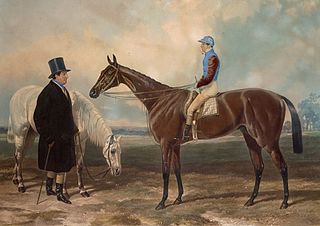
Newminster was a British Thoroughbred racehorse who won the St. Leger Stakes in 1851. He raced for four seasons, winning two of his ten races. He retired to stud in Yorkshire and became British champion sire in 1859 and 1863. Newminster sired the Derby winners Musjid and Hermit and the champion sires Adventurer and Lord Clifden. He was trained by John Scott and owned by Anthony Nichol throughout his racing career.
Gunner B was a British Thoroughbred racehorse and sire. In a racing career which lasted from May 1975 until October 1978 he contested thirty-three races, winning fourteen times, finishing second five times and third seven times. Originally trained in Yorkshire, he won twice as a two-year-old in 1975 before becoming a highly successful handicapper in the following season, when he won the Cecil Frail Handicap, Andy Capp Handicap and the Doonside Cup. He won three races in 1977 including the Group Three Diomed Stakes but appeared to have been well-exposed as a tough, consistent horse who was some way below the best. After joining the stable of Henry Cecil in 1978, however, he emerged as a genuinely top-class horse winning the Earl of Sefton Stakes, Brigadier Gerard Stakes, Prince of Wales's Stakes, Eclipse Stakes and Valdoe Stakes as well as finishing second in the Benson and Hedges Gold Cup and third in the Champion Stakes. After his retirement from racing he became a very successful sire of National Hunt horses. He died in 2003 at the age of thirty.

Trip To Paris is an Irish-bred, British-trained Thoroughbred racehorse. After showing modest form in his first two seasons he emerged as a top-class stayer as a four-year-old in 2015 after being gelded, winning the Chester Cup in May before recording his biggest win in the Ascot Gold Cup. He failed to win again after his Gold Cup success but was placed in a number of major races including a second in the Caulfield Cup. He was retired in July 2017 having won six of his twenty-seven races and earning over £800,000 in prize money.
Ile de Chypre was a British Thoroughbred racehorse and sire. After showing some promise as a juvenile he improved to become a leading handicapper in 1988, winning two races and being placed in the Old Newton Cup, Magnet Cup and Cambridgeshire Handicap. He was also involved in a bizarre incident at Royal Ascot in which his unseated his jockey after being allegedly stunned by an "ultrasonic gun". He reached his peak as a four-year-old in 1989 when he won the Tattersalls Rogers Gold Cup in Ireland before recording an upset victory in the International Stakes. In the same year he also finished second in the Coronation Cup and third in the Champion Stakes. He won one minor race in 1990 and returned after a lengthy absence to race six times without success in 1992.

Nun Nicer (1895–1915) was a British Thoroughbred racehorse and broodmare. As a two-year-old in 1897 she ran consistently, winning three of her nine races including the Manchester Summer Foal Plate and Hopeful Stakes as well as being placed on four occasions. In the following year she won the 1000 Guineas, Triennial Stakes, September Stakes and Palatine Plate and finished second in the Epsom Oaks and Coronation Stakes. As a four-year-old she ran second in the Stewards' Cup and won the Preis von Donausschingen in Germany. She made no impact as a broodmare.

Mrs Butterwick was a British Thoroughbred racehorse and broodmare. She spent most of her racing career competing in sprint races but recorded her biggest victory over a distance of one and a half miles when she won the Oaks Stakes in 1893. She showed good form as a two-year-old, winning three races and finishing second against older horses in the July Cup. In the following year she began her campaign with a defeat over five furlongs before being stepped up in distance for her upset win in the Oaks three days later. She spent the rest of her career competing in handicap races and won at least twice under big weights in 1894. After her retirement from racing she had considerable success as a dam of winners.
Petronel was a British Thoroughbred racehorse and sire. After showing promise when winning the Troy Stakes as a juvenile in 1879 he recorded a major upset when defeating his more fancied opponents to take the 2000 Guineas in the following spring. He had never been entered in the other British Classic Races but won at Royal Ascot and in several other top-class races that year. In 1881 he was one of the best staying horses in England, winning seven races including the Epsom Stakes, Rous Memorial Stakes, Great Yorkshire Handicap and Doncaster Cup as well as Queen's Plates at Stockbridge, Newmaket and Liverpool. He developed breathing problems and was never as good again although he won Queen's Plates at Stockbridge and Newcastle in 1882. After his retirement from racing he had some success as a breeding stallion.


